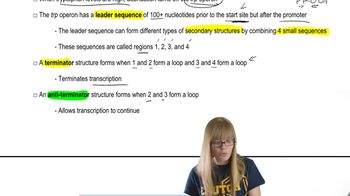Explain the circumstances under which attenuation of operon gene expression is advantageous to a bacterial organism. Would you expect attenuation to be found in a single-celled eukaryote? In a multicelled eukaryote?
 Sanders 3rd Edition
Sanders 3rd Edition Ch. 12 - Regulation of Gene Expression in Bacteria and Bacteriophage
Ch. 12 - Regulation of Gene Expression in Bacteria and Bacteriophage Problem 15
Problem 15Attenuation of trp operon transcription is controlled by the formation of stem-loop structures in mRNA. The attenuation function can be disrupted by mutations that alter the sequence of repeat DNA regions 1 to 4 and prevent the formation of mRNA stem loops. Describe the likely effects on attenuation of each of the following mutations under the conditions specified.
Mutated Region Tryptophan Level
a. Region 1 Low
b. Region 1 High
c. Region 2 Low
d. Region 2 High
e. Region 3 Low
f. Region 3 High
g. Region 4 Low
h. Region 4 High
 Verified step by step guidance
Verified step by step guidance
Verified Solution
Key Concepts
trp Operon and Attenuation

Stem-Loop Structures in mRNA

Impact of Mutations on Transcription Regulation

Consider the transcription of genes of the lac operon under two conditions: (1) when both glucose and lactose are present and (2) when glucose is absent and lactose is present. Describe the comparative levels of transcription of lac operon genes under these conditions, and explain the molecular basis for the difference.
In the lac operon, what are the likely effects on operon gene transcription of the mutations described in a–e?
Mutation of consensus sequence in the lac promoter
In the lac operon, what are the likely effects on operon gene transcription of the mutations described in a–e?
Mutation of the repressor binding site on the operator sequence
In the lac operon, what are the likely effects on operon gene transcription of the mutations described in a–e?
Mutation of the lacI gene affecting the allosteric site of the protein